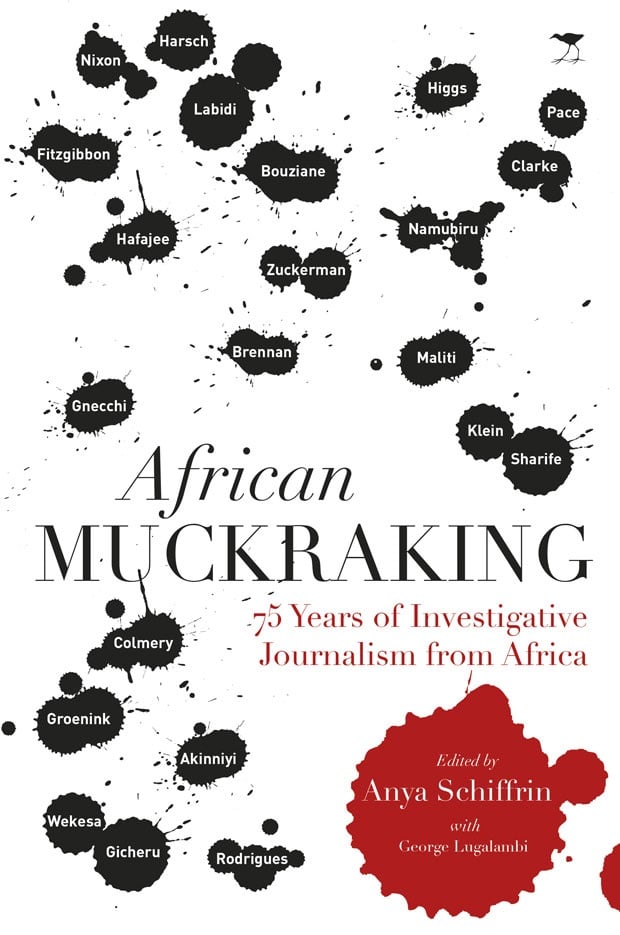
This extract, taken from African Muckraking: 75 Years of Investigative Journalism From Africa, exposes the murders and terror attacks that were committed during apartheid by the South African Police’s special unit at Vlakplaas.
Exposing apartheid’s death squads
Introduction by Anton Harber
In the late 1980s, apartheid was in its death throes, violent and unstable. State security forces were going all out to suppress a growing popular uprising, and this included mass detentions, torture and killings, overt and covert, legal and extralegal.
At the same time, elements of the ruling party were toying with the idea of negotiations, and cabinet ministers were secretly meeting with Nelson Mandela in prison.
It was this confluence of forces that allowed for one of the most sensational stories – which had been bubbling under the surface for some years – to burst into the open.
On 20 October 1989, the Weekly Mail, a small, ‘alternative,’ antiapartheid newspaper where I was co-editor, ran the contents of a sworn affidavit from a former policeman on death row, Albert Nofemela.
He had been sentenced to death for ordinary criminal murders, but said he had been part of a police hit squad that had targeted antiapartheid activists.
Nofemela’s life was saved by human rights lawyers who normally acted for his victims, but wanted him to tell his story and rushed to court to get a last-minute stay of execution.
Over the next few weeks, he gave the first explanations of various assassinations and disappearances that had taken place over a number of years.
Few took much notice, probably because he was a lowly black and criminal policeman and it was such a risky story.
Except for one crucial person: Nofemela’s commander, Captain Dirk Coetzee.
Coetzee saw that the game was up, fled into exile, and talked to a journalist he had known for years, Jacques Pauw, of a spunky Afrikaans ‘alternative’ newspaper, the Vrye Weekblad (Free Weekly).
On 17 November Coetzee’s story was splashed over four pages in Vrye Weekblad. ‘Meet Captain Dirk Johannes Coetzee,’ it said, ‘commander of a South African Police death squad.
He tells exclusively of the full gruesome details of political assassination, poisoning, bomb attacks in foreign countries and letter bombs.’
‘I was at the heart of the whore,’ he said, referring to a farm called Vlakplaas, headquarters of the killer squad.
The story spread around the world, though the mainstream local media mainly carried the official denials, leaving the ‘alternatives’ to pursue the story.
A few months earlier, these papers would likely have been confiscated or closed down (as had happened a year earlier), but there was enough political uncertainty in the air for the security forces to be constrained.
Mandela was released from prison within a few months and negotiations began.
This – and related stories which emerged over the next few months – was to be crucial in exposing, and constraining, the source of much of the violence of the transitional period and its origins in security-force elements who wanted to disrupt negotiations.
On 21 September 1990, Eddie Koch of the Weekly Mail published details of the Caprivi 200, a paramilitary unit trained by military intelligence at a secret base in Namibia, and which became central to the violence of that period.
On 19 July 1991, the Weekly Mail broke what became known as Inkathagate – secret police funding for the ANC’s rival, Inkatha.
In August came a story of how the Caprivi 200 were training Inkatha squads.
In January 1992, an Inkatha youth leader defected and gave an insider’s details of collaboration between military intelligence and Inkatha to counter the ANC.
In the same month, there was a story of vigilante units trained by the Caprivi 200 at work in other parts of the country.
In May 1992, journalist Drew Forrest exposed a network of front companies and safe houses being used in covert anti-ANC activities.
In September 1992, Louise Flanagan wrote about secret and illegal military operations in the Eastern Cape area. In that same month, Paul Stober and Eddie Koch exposed the Directorate of Covert Collections, another dirty-tricks operation in the military.
The newspapers were largely free from state interference during this period of negotiations.
But the scientist and doctor who had been named as the source of poison used against activists, Dr Lothar Neethling, sued the Vrye Weekblad and the Weekly Mail.
He lost, but won on appeal at the end of a lengthy case that drained the resources of Vrye Weekblad. Since then, more evidence has emerged against Neethling.
Vrye Weekblad, however, closed in February 1994, shortly before the country’s first democratic elections of 1994 went off relatively peacefully.
Bloody trail of the South African Police
Jacques Pauw, Die Vrye Weekblad, 19 November 1989, Durban, South
African (translated by Mia Swart)
Hit squad’s register of terror
Captain Dirk Coetzee admits that he had, until and including 1982, actively participated and helped plan various murders and terror attacks that were committed by the South African Police’s special unit at Vlakplaas.
Then he still kept in touch with several members of the hit squad and is aware of other acts of terror in the following years.
Here is his register of death:
The murder of the anti-apartheid activist and Durban lawyer Griffiths Mxenge: ‘In November 1981 I was called from Vlakplaas to Durban by Brigadier Van der Hoven, the then head of Security in Natal, where I was instructed to kill Mxenge.
‘The police knew that money for the ANC was channelled through him, but could not prove it. I was told to ensure that the murder looked like a robbery, because Van der Hoven said the police were not in the mood for another Biko case.
‘The security police in Durban pointed out his home to us and informed us about his movements. Captain Koos Vermeulen, Warrant Officer (now Lieutenant) Paul van Dyk and I laced four pieces of meat with strychnine to poison his dogs with and gave it to my Askaris, Almond Nofomela, David Tshikalange, Brain Ngulungwa and one Joe.
‘I instructed them clearly that he should be killed with knives and not be shot. I was then informed of all their movements: how they followed him, the poisoning of his three dogs and the trap they had set for him on the side of the road. They told me how they had stopped, kidnapped and taken him to the Umlazi Stadium where they stabbed him to death with knives. They also cut his throat and cut his ears off.
‘After the incident, I met them late at night at a pre-arranged meeting place where they had Mxenge’s jacket, watch, wallet and car keys. They assured me that it looks like a robbery.
‘I’ve since reported back to Van der Hoven, who instructed that the team must return to Pretoria.
‘There I was called to Brigadier Marius Schoon, who very anxiously wanted to know if we had left any traces. He ordered that Mxenge’s car should be burned immediately. It was done close to the Swaziland border.
‘I later heard that General Johan Coetzee, then Head of the Security Police, after my report back, had been called out of a meeting to hear the news of the successful operation.
‘The Askaris each received a R1 000 for their good work.’
The murder of two ANC members near Komatipoort:
‘After the army’s raid into Maputo in 1980, two suspected ANC members, Vusi and Ghost, were kidnapped and brought into South Africa. Ghost was taken to Vlakplaas where he later willingly started to work with the police. Vusi was held in the police cells in Brits, where he had the attitude of “Charge me or shoot me”.
‘Schoon gave the instruction that Vusi and another captive ANC member that was held at Vlakplaas, Peter, had to be gotten rid of. I collected Vusi (his MK name) from the police cells and took him to an abandoned farm near the Kopfontein border post where Captain Koos Vermeulen and Peter were already waiting for us.
‘I first let Vusi sign three different, predated invoices with three different pens so it would seem as if he was still alive and in our service three months later.
‘Vermeulen and I poured poison, that had been prepared by the forensics laboratory, into their cold drink and beer. Everyone talked about Lothar’s poison (General Lothar Neethling is head of the forensics laboratory). We were assured that 60 grams would be enough to let them die of a “heart attack”. The poison would not work. We increased the dosage to 360 grams each, but nothing happened.
‘We later took the two to Komatipoort where Paul van Dyk waited for us. From there we went to a farm nearby where Major Archie Flemington of Security at Komatipoort met us.
‘We gave Vusi and Peter sleep medication that had also been prepared by the forensics laboratory. We had been asked beforehand to keep notes of the effects of the sleep medication. When the two “terros/terries” (terrorists) were sufficiently confused, Vermeulen shot them through the head with a Makarov pistol with a silencer.
‘The two bodies were then burned along with wood and tyres that we found on a rubbish dump. It took seven hours before the bodies were burned out. The ash and the remains were dumped into the Komati River.
‘During the burning of the two “terries” security men of Komatipoort told me how they had distributed strong alcohol, laced with poison, among ANC members in Maputo. The poison is injected through the lids of the bottles with a micro needle.’
The burning of a ‘second Biko’ [...]
The murder of activist Patrick Makau and a young child [...]
The bomb attack on Chris Hani, military leader of Umkhonto We’Sizwe [...]
The murder of (exiled journalist, researcher and activist) Ruth First [...]
Hit on Marius Schoon [...]
A diamond trader is killed by the hit squad [...]
An ANC member is blown up in Swaziland [...]
A kidnapping from Swaziland [...]
The blow-up of ANC offices in London [...]
Coetzee speaks of several other days of terror that he personally was involved in or that he knew of. He speaks of other incidents, especially in Swaziland where ANC members were murdered and kidnapped.
• African Muckraking: 75 Years of Investigative Journalism From Africa
Editor: Anya Schiffrin with George Lugalambi
RRP: R280
Available at all good bookstores




 Publications
Publications
 Partners
Partners








